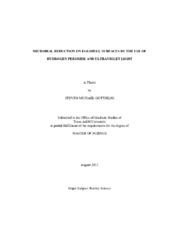| dc.contributor.advisor | Coufal, Craig D. | |
| dc.creator | Gottselig, Steven Michael | |
| dc.date.accessioned | 2011-10-21T22:03:59Z | |
| dc.date.accessioned | 2011-10-22T07:12:03Z | |
| dc.date.available | 2011-10-21T22:03:59Z | |
| dc.date.available | 2011-10-22T07:12:03Z | |
| dc.date.created | 2011-08 | |
| dc.date.issued | 2011-10-21 | |
| dc.date.submitted | August 2011 | |
| dc.identifier.uri | https://hdl.handle.net/1969.1/ETD-TAMU-2011-08-10117 | |
| dc.description.abstract | Microbial Reduction on Eggshell Surfaces by the use of Hydrogen Peroxide and Ultraviolet Light. (August 2011)
Steven Michael Gottselig, B.S., Texas A&M University
Chair of Advisory Committee: Dr. Craig Coufal
The effect of hydrogen peroxide (H2O2) in combination with ultraviolet light (UV) as an egg sanitization process on eggshell surfaces was studied. Preliminary experiments were conducted to develop an optimized methodology for eggshell disinfection that will be an effective and efficient way to reduce microorganisms on hatching eggs. Several experiments were conducted to reduce the natural flora found on the eggshell surface. Hatching eggs were collected from White Leghorn hens housed in floor pens with nest boxes. Eggs had no adhering organic material present. Results from these experiments led to the modification of the prototype equipment as well as the treatment application methodology. Following the experiments to optimize the methodology for H2O2 spraying and UV exposure time, the methodology was applied to eggs inoculated with Salmonella Typhimurium. Eggshell crush and rub methodology was used to enumerate bacteria within the pores and membranes of the egg. The optimized H2O2 and UV combination treatment process was then applied to commercial broiler breeder hatching eggs to evaluate the effects on hatchability.
Based on the parameters tested, results indicate that two applications of 3% H2O2 followed by 5 sec of UV exposure after each application produced the most consistent microbial reductions on eggshells. To enhance these effects, the addition of a 180° rotation between the two applications showed to be effective at further reducing the natural flora found on the eggshell surface. Studies using this optimal methodology on eggs inoculated with Salmonella at 9 log10 CFU/egg yielded greater than 5 log10 CFU/egg reductions. However, this methodology had little to no effect on reducing bacteria found within the pores and membranes of the eggs inoculated with Salmonella. These findings indicate that the effects of the disinfection process are largely limited to the eggshell surface. Hatch studies showed significant reductions in eggshell microbial levels under field conditions with eggs having large amounts of organic material present on the shell surface. Hatchability was maintained after treatment when compared to untreated eggs. Additional studies are needed to develop advanced equipment to apply this technology under commercial conditions. | en |
| dc.format.mimetype | application/pdf | |
| dc.language.iso | en_US | |
| dc.subject | Disinfection | en |
| dc.subject | Eggshell | en |
| dc.subject | Ultraviolet Light | en |
| dc.subject | Hydrogen Peroxide | en |
| dc.title | Microbial Reduction on Eggshell Surfaces by the use of Hydrogen Peroxide and Ultraviolet Light | en |
| dc.type | Thesis | en |
| thesis.degree.department | Poultry Science | en |
| thesis.degree.discipline | Poultry Science | en |
| thesis.degree.grantor | Texas A&M University | en |
| thesis.degree.name | Master of Science | en |
| thesis.degree.level | Masters | en |
| dc.contributor.committeeMember | Duong, Tri | |
| dc.contributor.committeeMember | Taylor, Matthew | |
| dc.type.genre | thesis | en |
| dc.type.material | text | en |


